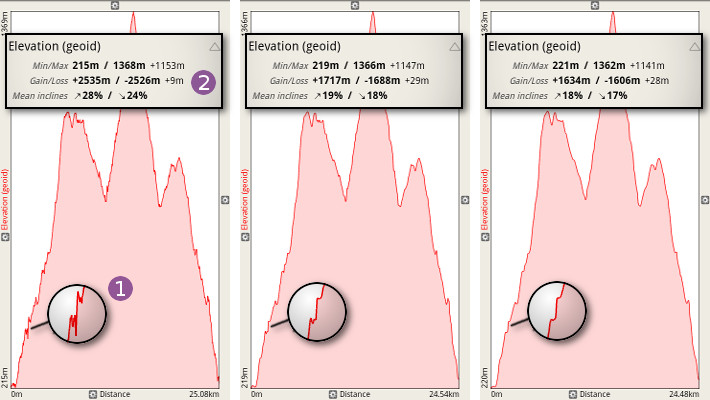Table of Contents
Details and statistics
Statistics are given in the details page of landmarks.
Statistics
Display the details of a track to get its complete details page, made of
- A preview section
 (on the default map);
(on the default map); - A complete statistics section
 ;
; - A list of events occurring during the track
 .
.
The statistics section is divided in sub-sections:
- The overall statistics
 , listing
, listing “Date”(the start date and time),“Time”(the total time elapsed between the start and the end),“Stopped”(the total stopped time, sum of rest time of all breaks),“Length”(the total length) and“Calories”(estimation based on the length, speed, inclines and user weight); - Statistics on elevations
 , listing
, listing “Min/Max”(the overall minimum and maximum elevations) and“Gain/Loss”(the cumulative elevation gain and loss, see below); - Statistics on moving speeds
 (ignoring stopped times), listing
(ignoring stopped times), listing “Total”(the speed when moving, computed from the total length and the moving time; the total time minus the stopped time) and“Up”(the ascent speed).
Click on “Events” ![]() to display the list of events occurring during the track, as well as their location on the track profile just above. Events include start and end time, locations of minimum and maximum elevations, locations of breaks (along with the rest time for each break), etc.
to display the list of events occurring during the track, as well as their location on the track profile just above. Events include start and end time, locations of minimum and maximum elevations, locations of breaks (along with the rest time for each break), etc.
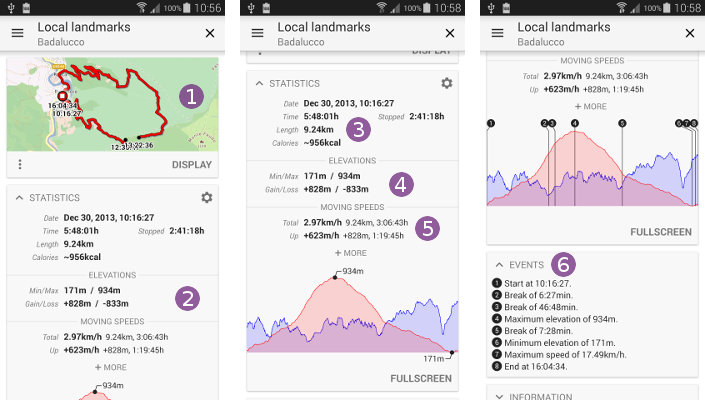
Graphics
The statistics details page gives a static preview of the elevation and speed profile. In order to get a fullscreen and dynamic version, click on “Fullscreen” ![]() . On the fullsccreen page, you can:
. On the fullsccreen page, you can:
- Click anywhere on the profile
 to get the exact values at this location;
to get the exact values at this location; - Click on the
“Change X axis” icon to change the abscissa to
icon to change the abscissa to “Length”or“Time”; - Click on one of the
“Change Y axis” icon to change one of the ordinates. The list of available fields
icon to change one of the ordinates. The list of available fields  depends on the data included in the track file.
depends on the data included in the track file.
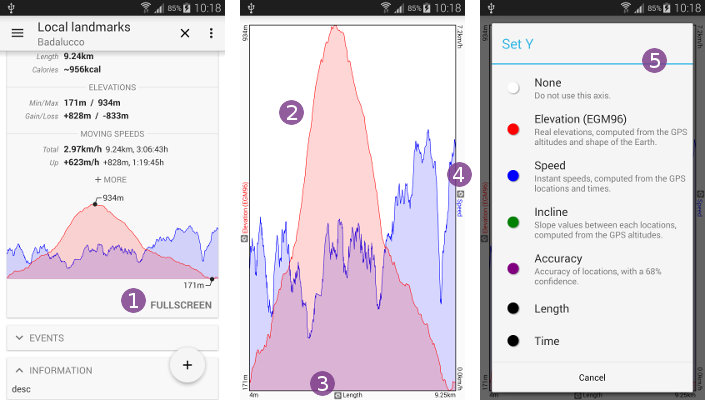
How to change statistics settings?
You can change various parameters to control the way statistics are computed. To do so, click on the “Statistics settings” icon ![]() .
.
Parameters you can change are:
“Noise reduction” defines how much to filter noises and erroneous values before computing statistics. It mainly impact the gain computation (see below);
defines how much to filter noises and erroneous values before computing statistics. It mainly impact the gain computation (see below);“Moving threshold” defines the minimum speed at which you're considered as moving;
defines the minimum speed at which you're considered as moving;“Min. break time” defines the minimum rest time a break needs to last to be taken into account;
defines the minimum rest time a break needs to last to be taken into account;“User weight” defines the weight used when computing consumed calories;
defines the weight used when computing consumed calories;“Include inter-segment gaps” defines if the gaps (elapsed time and distance if any) between segments of tracks must be taken into account;
defines if the gaps (elapsed time and distance if any) between segments of tracks must be taken into account;“Barometric elevation” defines if barometric elevations (if recorded with the track) must be used instead of GPS elevations.
defines if barometric elevations (if recorded with the track) must be used instead of GPS elevations.
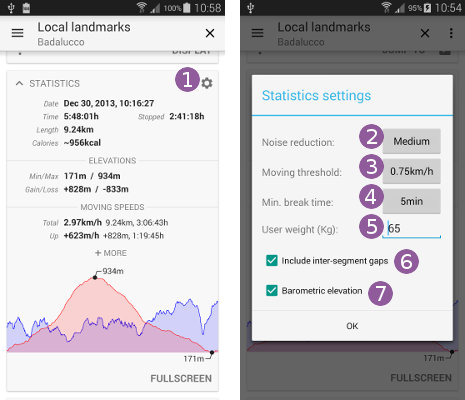
How to export statistics and graphics data?
Before computing statistics and displaying graphics of a track, the application will process its raw data (usually recorded using the GPS) based on the chosen settings to remove recording inaccuracies and discrepancies. You can export the processed data in a .CSV file:
- In the details view of a track, click on the action menu
 ;
; - Select
“Export as…” ;
; - Choose
“CSV file / Profile (Data file)” .
.
![]() After the export, you can easily share/upload the generated file using the
After the export, you can easily share/upload the generated file using the “Share” button.
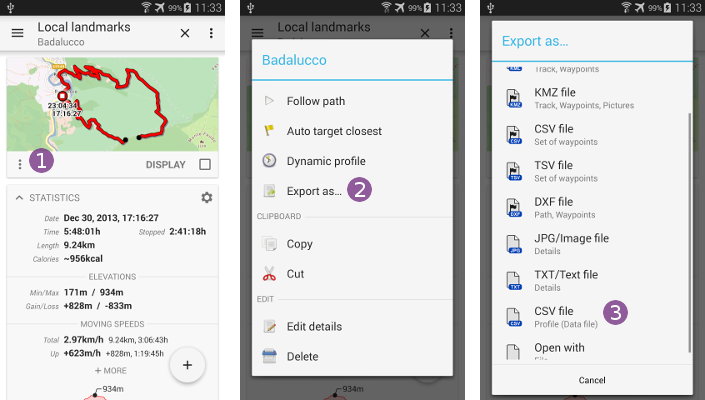
The following fields are exported:
“Longitude”and“Latitude”, the coordinates of the location buckets in the WGS84 (GPS) datum. A location bucket is a set of one or more locations from the original track, grouped together for algorithmic reasons;“Distance”, the cumulative distance from the start point of the buckets, in meter (m);“Time”, the cumulative time from the start date of the buckets, in second (s);“Elevation”, the mean elevation values computed for the buckets, based on the GPS altitude values, in meter (m), over the EGM96 (Geoid) ellipsoid;“Speed”, the mean speed values computed for the buckets, in meters per second (m/s);“Slope”, the mean slope values computed for the buckets, in percent (%);“Sea-level pressure”, the calibrated, sea-level equivalent mean pressure values computed for the buckets, in hectopascal (hpa);“Pressure”, the un-calibrated, raw mean pressure values computed for the buckets, in hectopascal (hpa);“Barometric elevation”, the mean elevation values computed for the buckets, based on the pressure values, in meters (m), over the EGM96 (Geoid) ellipsoid;“Accuracy”, the mean accuracy (with a 68% confidence) values computed for the buckets, in meter (m);“Elevation (diff.)”, the mean difference values between the GPS elevations and the barometric elevations for the buckets, in meter (m);
Gain and loss computation
The gain is an important value that helps to appreciate the overall profile of a track. A small gain means that the track is mostly flat, a high gain means you'll have to climb a lot.
Strictly speaking,
- The gain is the sum of all positive altitude differences along the track;
- The loss is the sum of all negative altitude differences along the track.
In order to compute these values, it's important to define more precisely what means “along the track”.
A first definition would be to only take into account the altitude differences between mountain passes and summits. If you start a hike at +150m, climb to a summit at +500m, then go back to your start location at +150m, your gain will be 350m. In practice, trails usually don't go straight forward to the summit, but will go uphill for some time, then downhill a little bit, then uphill again, etc. This first definition doesn't take all these small changes into account, and will then lead to an under-estimated gain.
Another definition would then be to take into account the altitude differences between all the locations that make the track. Now imagine a track recorded with a GPS along the sea. The GPS, having an imperfect accuracy, will record altitudes of [+1m, +2m, 0m, +1m, -1m, +2m, …]. With this small segment of 6 locations, we have a gain of +5m. With a track of 1000 locations, it would lead to a gain of more than +800m which is a very over-estimated gain, since the track is along a flat shoreline and should have no gain.
At then end, the “perfect” gain definition would be something between these two ones. In order to compute the best gain approximation, the application will first remove noises from the track (including the GPS inaccuracy) to create a smoother altitude profile, and then compute the gain based on each location altitudes.
![]() You can disable or increase the noise reduction amount in the statistics settings (see above).
You can disable or increase the noise reduction amount in the statistics settings (see above).
Here is the effect of the noise reduction on a track profile and gain computation:
- On the left, the noise reduction is disabled. The profile displays the unmodified jagged and spiky altitudes
 (mostly due to the GPS inaccuracies), resulting in a high gain value
(mostly due to the GPS inaccuracies), resulting in a high gain value  (+2535m);
(+2535m); - In the middle, the noise reduction is on
“medium”, which is the default setting. Most noises are removed, resulting in a much smaller and less polluted gain value (+1717m); - On the right, the noise reduction is on
“big”. The profile smooth, with minors altitude changes lost, resulting in an even smaller gain value (+1634m).
![]() The first gain definition given above, gives an approximate under-estimation value of +1600m for this same track.
The first gain definition given above, gives an approximate under-estimation value of +1600m for this same track.
